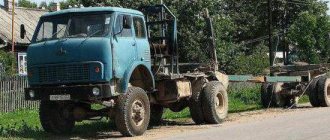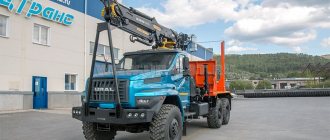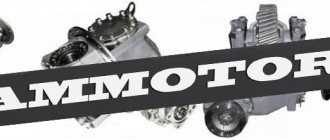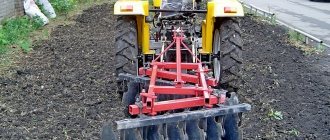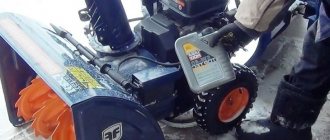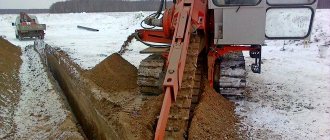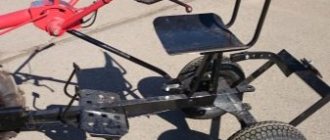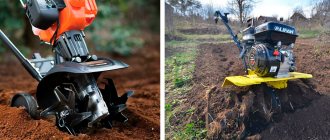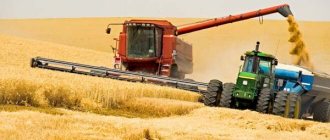A timber truck is just as necessary in the process of logging work as shafting machines. Since wood needs to be processed as quickly as possible after felling, finished stacks of logs must be transported to the processing site as soon as possible. Such a vehicle has a special cargo compartment, onto which logs are loaded and transported. In addition, the cargo body has an additional horsebox, with which you can connect several trailers to transport a large volume of timber.
A timber tractor differs from other trucks in its increased maneuverability. Such vehicles can overcome extremely difficult sections of the road. Timber trucks easily drive through loose damp soil, small rubble, and other off-road conditions.
How are timber trucks constructed?
Loading onto timber trucks is done in this way. Hitching straps are placed on the bottom of the logging trailer. After this, the laying out of timber begins. Laying out can be done either one log at a time or in a whole bunch at once. The final stage of loading is securing the logs with chains. The wood is then transported to a warehouse or final location for processing.
Upon arrival at the destination, the logs are unloaded. Using a crane, the specialist removes the entire stack of logs, most often this is done together with fastening belts, which are replaced at the end of the entire procedure. If there is no crane, then unloading is carried out using a manipulator, but only one log at a time. It is not possible to unload the entire stack using a manipulator. The video will tell you in more detail how timber trucks work.
Differences between timber carriers and log carriers
First of all, it should be said that these are very similar types of special equipment, which are trucks designed for transporting long cargo, mainly logs.
Special equipment is classified according to its load capacity, maximum length of transported cargo and wheel arrangement. Below we will consider the most common types of specialized vehicles, which will make it possible to answer the question of which timber truck is better to buy: KAMAZ or Ural.
Main types of technology:
- flatbed truck or specialized platform (using the structure you can transport workpieces that are held by bunks);
- a tractor with a trailer or semi-trailer, equipped with special fixing elements (models can be equipped with an oversized body);
- road trains are quite powerful and capacious special equipment, often equipped with an additional crane for the efficiency and convenience of loading and unloading operations.
Each of the presented types of cargo vehicles has its own characteristics, advantages and purpose, which predetermine the decision to purchase one or another option.
A timber truck with a manipulator is the most common variation of special equipment, which has the ability to transport multi-ton logs and independently load cargo. One of the most important advantages is complete autonomy.
A log carrier is one of the types of timber carrier, which is used for transporting cross-cut timber (logs up to 8 m). The main distinguishing characteristic from a timber carrier is its higher cross-country ability.
Manufacturers KAMAZ and Ural use various solutions to best meet the needs of enterprises in terms of cross-country ability:
- the use of a chassis with several driving axles (this can be 6x4, 6x6, and so on)
- the use of additional track chains, resulting in the production of more powerful, reliable and passable models of wheeled and tracked vehicles.
The presence of such a wide variety of presented models of timber and log carriers somewhat complicates the process of choosing the most suitable option. However, specialists from the Novosibirsk Automotive and Tractor Plant are always ready to help you choose a model, so the purchase is likely to be successful and profitable.
Characteristics of timber trucks
Timber trucks transporting wood have certain features:
- the basis is a serial truck chassis and an additional superstructure to it. For example, MAZ specialists must install a timber superstructure on their chassis. A timber truck that works directly in the forest, that is, drives off-road, is distinguished by all-wheel drive, differential locks, and high ground clearance
- The forest frame is the basis of two longitudinal spars. U-shaped supports, in other words conics, are fixed on top of it. The timber frame is attached directly to the car frame. Experts note that the best timber truck is one whose bunks are designed to allow longitudinal movement along the timber frame for optimal retention of logs. Each bundle of wood must lie inside at least two pairs of bunks. However, the more bunks that hold a bundle of timber, the more reliable the transportation.
- To prevent the logs from moving forward, towards the cabin, there must be a safety grid on the front of the frame, the height of which must be greater than the height of the bunks. This way, no log will move forward while driving or braking. To secure a bundle of timber, cable fastenings are used - strappings. During the trip, the logs are placed more tightly, as a result, the tension of the harness weakens. For this reason, the driver must periodically check and tighten them.
- The forest frame is also equipped with protective covers that prevent large branches, logs, stones or pieces of ice from falling onto rotating and unprotected parts of the machine, for example, wheels, brake chambers, driveshafts, wiring. In addition, there may be a protective cross beam that prevents damage to the scaffolding frame or casing.
- Timber trucks with hydraulic manipulators handle loading and unloading independently. To do this, the vehicle chassis must contain a power take-off and an oil pump. To protect the operator from bad weather, some brands of manipulators are equipped with a separate cabin
- additional light. Most brands of timber trucks have floodlights to illuminate the road both ahead and behind.
- large volume fuel tank. Since there are no gas stations on forest roads, and fuel consumption in the forest is quite significant, timber trucks have tanks of impressive volume.
The above characteristics of timber trucks allow the use of this equipment in a wide variety of conditions.
Domestic market
Let's start our review with domestic manufacturers of timber trucks.
ZIL
A veteran in this area is the ZIL 131. This model has been produced in Moscow since 2002. It’s worth clarifying right away that the equipment was not initially positioned as a vehicle for transporting timber.
ZIL 131
However, the vehicle is designed for transporting bulk and solid cargo, in addition, it is adapted for the needs of the Russian army. This type of equipment is powered by domestic diesel engines of the MMZ, YaMZ-236 and D-243 series.
The basic color of the cabin is khaki. It is worth noting that the cabin is quite spacious, which is not typical for the domestic truck industry, and is equipped with air conditioning and ventilation systems.
Models designed for transporting timber are equipped with a manipulator; there is usually no trailer. This feature prevents the use of the equipment for industrial purposes.
KrAZ
These are powerful trucks designed to operate in various climatic conditions and on difficult terrain. The machine is quite competitive not only in the domestic, but also in the Western market of special equipment.
“KrAZ” differs from its European analogues in its low cost, while not inferior to the build quality and technical characteristics. The only drawback of the technology is the engine is too power-hungry and does not meet European environmental safety standards.
If we consider the KrAZ as a timber truck with a manipulator, we can highlight the following features:
- Semi-elliptic springs on the front suspension, complemented by telescopic shock absorbers.
- The wheel formula is of two types: 6x4 and 6x6.
- Eight-cylinder diesel engine with power up to 330 hp. With.
- Hydraulic power steering.
- Drum brake system and double-disc friction clutch.
KrAZ
Among the popular models of timber trucks based on the KrAZ, two modifications can be distinguished: 255 and 64372.
The KrAZ 255 B timber truck model is equipped with a winch and a transport platform as standard.
Kamaz
Two models from this manufacturer are used as timber trucks: 43118 and 4310. These models are equipped with all-wheel drive and single-wheeled chassis. It is possible to pump up tire pressure.
Kamaz
It is worth noting that Kamaz timber trucks have good ground clearance, which makes it possible to use the equipment even in wetlands. In the basic modification, the models leave the conveyor with a hydraulic manipulator. At the request of the customer, it is possible to optionally install a winch.
MAZ
Considering that Belarus is famous for its timber industry, it is not surprising that the Minsk Automobile Plant produces timber trucks. This manufacturer is most interested in the design features of towed devices.
- Long-bed tractor. Designed for transportation of small-sized loads and medium-length rods. The short wheelbase of the equipment makes it possible to transport cargo over significant distances from logging sites.
- The tractor is equipped with a rotating bunk. Such modifications are usually combined with a dissolution trailer. This design makes it possible to transport timber with a long trunk, while the equipment is characterized by good maneuverability.
- Semitrailer. If you combine this device with a truck tractor, you can transport logs of any length. The transportation distance in this case does not play a big role.
Please note that all timber trucks are equipped with manipulators that are designed to work not only with tree trunks, but also with pipes. The boom reach reaches seven meters.
MAZ
Design features
There are four main parts in the design of a timber truck:
- Platform. It is equipped with special vertical supports (called bunks) for reliable fixation of logs. They are placed at equal distances on both sides of the platform. Some trailer models have sliding bunks that make loading wood easier.
- Chassis and wheel axles (depending on the purpose and region of operation, trailers are equipped with all-wheel drive, a pair locking option, a winch, etc.).
- Forest fastening system (logs are tied with cables, which are checked for tension before shipping).
- Hydraulic manipulator – designed to carry out loading and unloading operations without the use of other special equipment.
Types and technical characteristics
The timber trailer is made in the form of a platform for arrangement and fastening of lumber. To load and unload timber onto the platform, a hydraulic manipulator is used, which is included in the design of the equipment. The timber carrier transports wood from its felling sites to wood processing enterprises and warehouse complexes.
Manufacturers offer to buy a semi-trailer for transporting:
- Wood of varying degrees of harvesting - from felled forest to finished building materials (boards, logs);
- Pipe rolling;
- Metal;
- Supports and reinforced concrete pillars.
Timber semi-trailers are classified into groups depending on their design features and purpose:
- Road trains and trailers;
- Timber platforms connected to the tractor;
- Flatbed truck with fastenings for securing the forest.
Transportation of lumber is also carried out by rail on special platforms. This method is preferable when it is necessary to transport timber over long distances.
The production of log trucks is made from high-strength materials, which ensures reliable operation and a long service life of the equipment when operating in intensive mode and in difficult weather conditions. During long-term use, the semi-trailer may require minor repairs; the price depends on the complexity of the breakdown.
